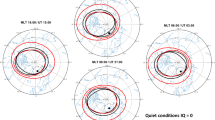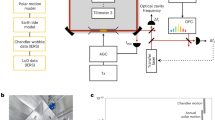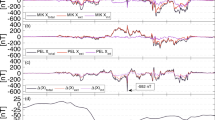Abstract
GEOSTATIONARY satellites are able to monitor amplitude, phase, plane of polarisation (Faraday rotation) and group retardation of radio waves passing through the ionosphere with improved temporal resolution, although some of these parameters were earlier measured using orbiting satellites. An extensive experiment has been conducted on Faraday rotation measurements at a chain of stations covering a latitude region from the magnetic equator to 45°N dip (30°N geog.) in the Indian sub-continent using 140 MHz radio beacons received from ATS-6 satellite1. We report here the first evidence of an irregularity belt and its movement during a magnetic storm.
This is a preview of subscription content, access via your institution
Access options
Subscribe to this journal
Receive 51 print issues and online access
$199.00 per year
only $3.90 per issue
Buy this article
- Purchase on Springer Link
- Instant access to full article PDF
Prices may be subject to local taxes which are calculated during checkout
Similar content being viewed by others
References
Deshpande, M. R. et al. Nature 267, 599–600 (1977).
Chandra, H. & Rastogi, R. G. Curr. Sci. 43, 567–568 (1974).
Aarons, J., Mullen, J. & Sunanda Basu, J. geophys. Res. 68, 3159–3168 (1964).
Author information
Authors and Affiliations
Rights and permissions
About this article
Cite this article
VATS, H., CHANDRA, H., DESHPANDE, M. et al. Equatorial irregularity belt and its movement during a magnetic storm. Nature 272, 345–346 (1978). https://doi.org/10.1038/272345a0
Received:
Accepted:
Published:
Issue Date:
DOI: https://doi.org/10.1038/272345a0
This article is cited by
-
Morphology of equatorial plasma bubbles during low and high solar activity years over Indian sector
Astrophysics and Space Science (2017)
Comments
By submitting a comment you agree to abide by our Terms and Community Guidelines. If you find something abusive or that does not comply with our terms or guidelines please flag it as inappropriate.



